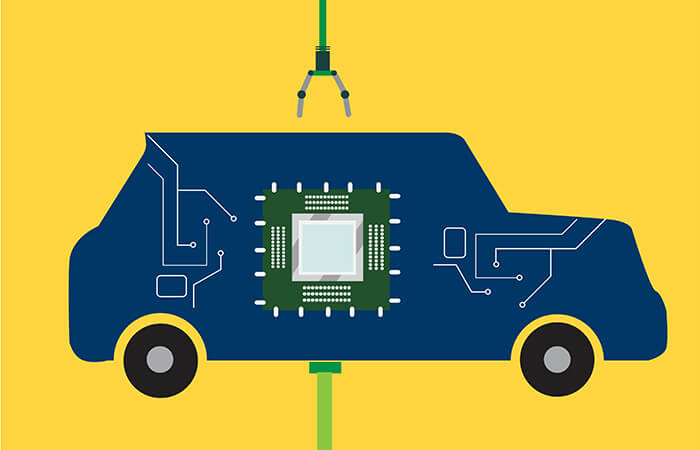Semiconductors are the backbone of our world and the technology that runs our lives, businesses, health systems, entertainment, and more. They do an incredible number of often unappreciated tasks from conducting electricity to processing information.
While we have semiconductors to thank for so much in our lives, for them to function in the cell phones we keep in our pockets or the laptops in our bags, they have to be tiny. That, combined with the way the technology works, makes semiconductors very susceptible to contamination during the manufacturing process. Let’s take a deeper look at exactly why that is.
Miniaturization
Semiconductors are characterized by their small size and intricate structures. As technology advances, the size of semiconductor devices continues to shrink, with components reaching nanoscale dimensions. Even a tiny particle or impurity on the surface of a semiconductor can have a significant impact on its functionality. Contamination can disrupt the precise patterns and structures within the semiconductor, leading to defects, electrical malfunctions, or complete failure.
Electric Field Interactions
Semiconductors rely on precise electrical properties to function correctly. Contaminants can alter the electrical characteristics by interfering with the electric fields within the semiconductor. Even a small particle or impurity can create localized electric fields that deviate from the desired behavior, affecting the performance and reliability of the semiconductor device. Unintended electric field interactions caused by contamination can result in reduced signal quality, increased power consumption, or even short circuits.
Thermal Effects
Semiconductor devices generate heat during operation, and effective heat dissipation is critical for their performance and reliability. Contamination, such as dust or foreign particles, can impede heat transfer or act as thermal insulators, leading to elevated temperatures in localized areas. High temperatures can degrade the performance of semiconductors, alter their electrical characteristics, and potentially cause thermal damage or device failure.
Chemical Reactions
Semiconductors can undergo chemical reactions with certain contaminants. Moisture, gasses, or chemicals can react with the semiconductor materials, leading to the formation of unwanted compounds or corrosion. These reactions can change the material properties, alter the conductivity, introduce impurity levels, or induce structural defects, thereby degrading the semiconductor’s performance or rendering it non-functional.
Surface Contamination
The surfaces of semiconductors are particularly vulnerable to contamination. Particles, like dust, oils, or residues, that accumulate on the surface can create barriers or insulating layers that interfere with electrical connections or impede heat dissipation. Surface contamination can affect the bonding processes, alter the adhesion properties, or introduce defects in the semiconductor’s thin films or layers, compromising device functionality.
Manufacturing Processes
Semiconductor fabrication involves multiple complex manufacturing processes, such as photolithography, deposition, etching, and wafer handling. Each step presents opportunities for contamination to occur. Even minor deviations in process parameters, improper handling, or inadequate cleanliness controls can introduce contaminants. Contamination at any stage of the manufacturing process can result in defective devices, yield losses, or compromised device performance.
What Happens if A Semiconductor Is Contaminated?
If a semiconductor is contaminated during production, first and foremost, it is most likely not the only one to experience contamination. And these particles can wreak havoc on the intricate semiconductors.
For example, they can cause unintended leakage currents or alter the electrical characteristics of the semiconductor. Thus, the contaminated semiconductors could consume more power than intended, causing increased energy consumption, reduced battery life, or inefficient operation.
In turn, the semiconductor could underperform, experience malfunctions, perform unstably, or fail completely.
If the contamination is missed during manufacturing and is installed in devices, this can lead to unsatisfied customers, unexplained problems, and, if it is realized a whole batch might have been contaminated, recalls. Whether there is a recall or simply a large number of people leaving negative reviews, the reputation of the company will undoubtedly be impacted.
The best way to avoid yield loss, recalls, reputation damage, and other negative effects is to ensure quality is consistent across the board and avoid contamination from the start.
How Can You Avoid Contamination In Semiconductor Manufacturing?
The only way to ensure semiconductors are not contaminated during manufacturing is to produce them in a cleanroom environment with proper ventilation, airflow strategy, and filtration.
Another aspect of manufacturing semiconductors, though, is the etching process. Etching uses a large amount of water, which must be just as pure as the air. This is called ultrapure water (UPW).
UPW is made in a multistep process. The first step is filtering out any large debris, followed by either two pass Reverse Osmosis, Demineralization and Reverse Osmosis, or High Efficiency Reverse Osmosis (HERO). Some UPW users also choose to incorporate Activated Carbon or sodium bisulfite to dechlorinate the water, which is a mixture of physical and chemical processes.
Next is the primary treatment phase. During this phase, you use ultraviolet light and electrode ionization or a mixed bed ion to demineralize the water. Some choose to use dissolved oxygen removal through a membrane or a vacuum degasification.
The ultraviolet light is used to kill viable contamination. As the energy from the light goes into the particle, it damages the microorganisms’ internal structures.
Finally, the ultrapure water goes through the polishing stage. While the most important step, this is also often the most expensive portion of the process. This step uses ultraviolet light and heat exchange to control the temperature of the water supply. UPW is usually made in large quantities, so changing or controlling the temperature of this amount of water can be challenging.
Lastly, non-regenerable ion exchange with membrane degasification and ultrafiltration is used to finalize the water filtration to reach the required particle level.
Now your UPW is safe to use in semiconductor manufacturing to avoid contamination.
This whole process can be daunting and overwhelming, but here at LWS, our goal is to make even these complicated processes easy. We break down complex topics like these every week in our free Knowledge Center. Make your account today.


